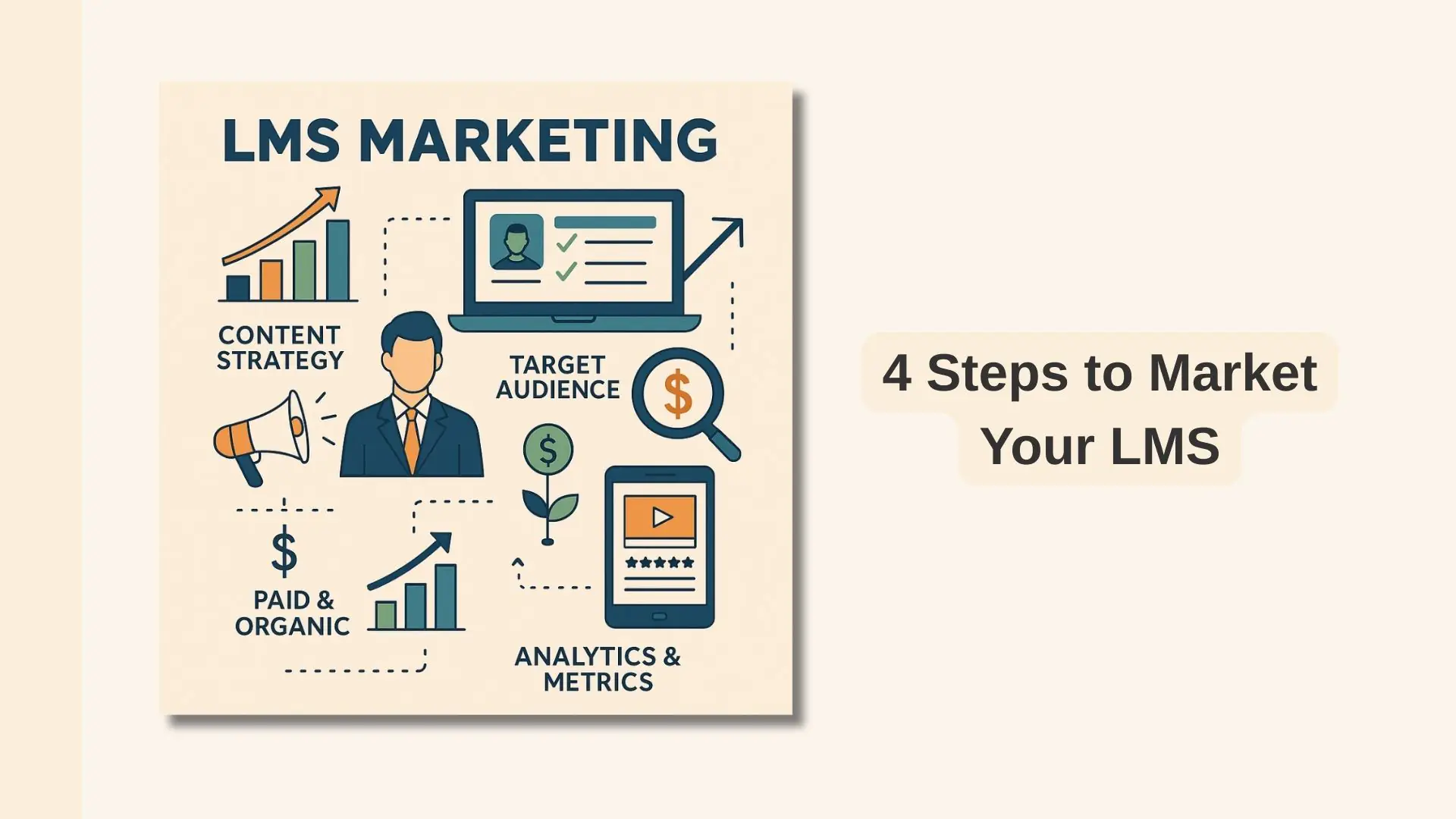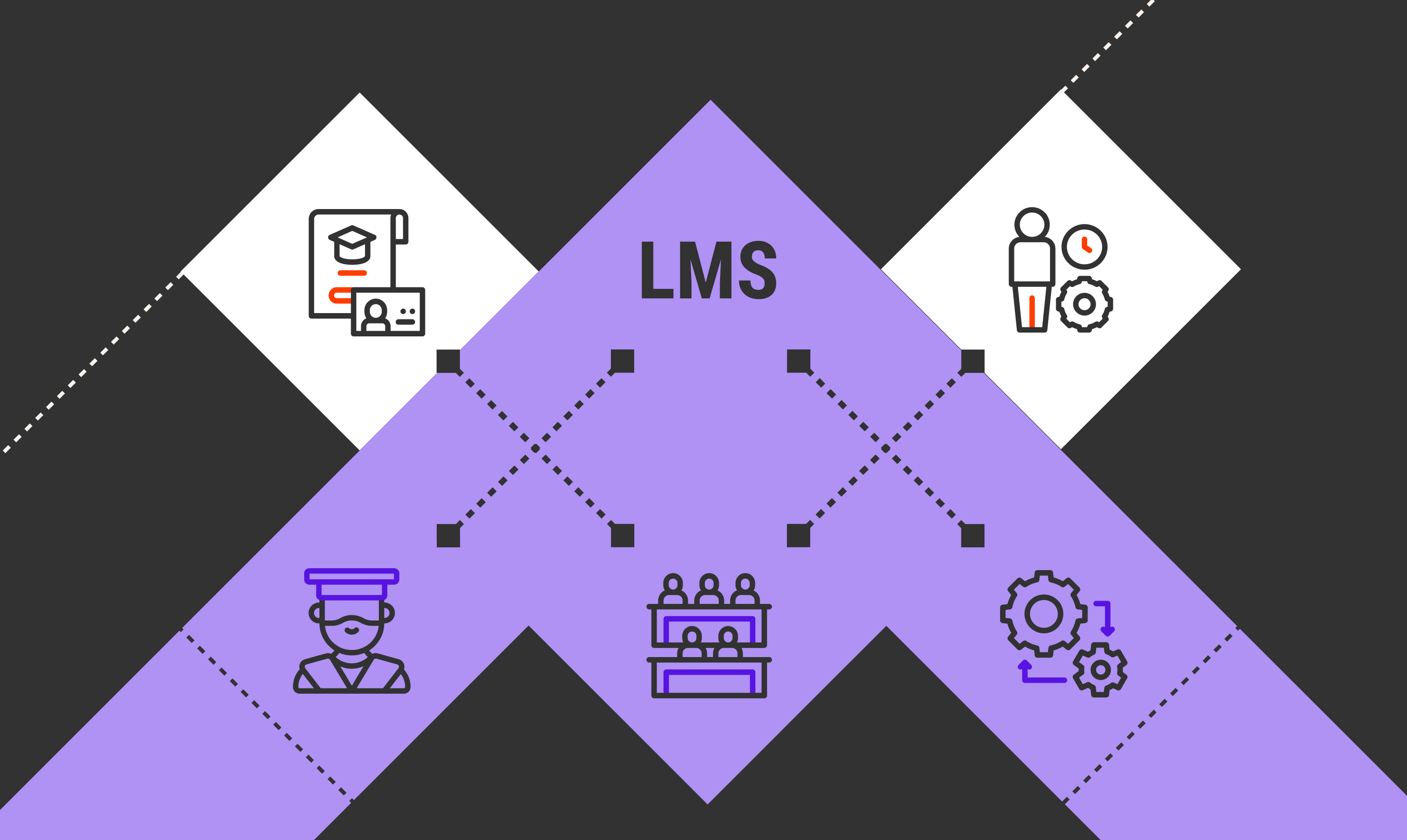As our decade-long experience as a provider of LMS development and integration services shows, the effective LMS marketing strategy you choose will determine the future success of your company.
So, what do you need to do to bring your solution out from under the shadow of already existing proposals? Start by conducting in-depth market research to determine what established LMS companies are doing to market their solutions. You’ll need to examine how quickly they grew as well as their customer acquisition and retention rates since the time they first entered the eLearning market.
Pro tip. At this step, it is important to answer two questions:
- What does your customer need?
- What LMS marketing strategies have successful LMS vendors been using to expand their customer base?
In addition, you’ll need to develop your buyer persona, a fictional profile possessing the attributes of your ideal clients. Depending on your target audience, you may have more than one buyer persona to represent different targeted groups. The content you develop for marketing and all your subsequent marketing strategies will focus on the resulting persona profile.

LMS Marketing Made Simple: audience, goals, social media, content, paid vs. organic, and metrics — all in one strategy.
Know Your Specialization
It’s important to understand that pitches like easy to use, focused on learner needs, economical, etc., won’t set you apart from hundreds of other LMS vendors out there. Taking a generic approach means you’ll eventually lose your potential clients to those who specialize.
Like in any other business, you need to identify and effectively communicate your unique selling proposition (USP) to your target market. From an eLearning perspective, you’ll need to understand your unique specialization in eLearning and how it is going to benefit your targeted customers in accomplishing their goals.
Asking the following questions should help you define your unique selling points and know where you fit in the LMS market:
- What is an LMS?
- How relevant is your LMS solution to your core target audience?
- How to choose the best LMS?
- How different is your LMS solution from those of your competitors?
- How many people are willing to pay for your LMS solution?
- What is an Open Source LMS?
- Which LMS integrations will help you achieve your business goals?
Define Your Marketing Goals
Just as any journey begins with choosing a direction to take the first step, building your marketing strategy should start with defining what you want to achieve. Immediately after that, your expectations regarding return on investment (ROI) should be. The best practice for defining your own goals is to choose the SMART framework:
- Specific – a clear statement of what you are going to achieve.
- Measurable – all goals must be measurable, which means having their own metrics.
- Attainable – for goals to be measurable, they must be realistic.
- Relevant – when forming goals, do not forget about business priorities.
- Timely – unfortunately, you will not have all the time in the world to achieve your goals; it is better to set a deadline.
To market your LMS effectively, we recommend using the following key performance indicators (KPIs):
- Traffic sources – SEO, PPC, social media, email, and content marketing.
- Unique website visitors – to measure reach.
- Inbound leads – number of potential clients engaged.
- Demo sign-ups or free trials – a strong sign of product interest.
- Lead-to-customer conversion rate – how many leads turn into paying clients.
- Visitor-to-lead conversion rate – efficiency of your funnel.
- Click-through rate (CTR) – for ads and email campaigns.
- Cost per acquisition (CPA) – what you pay to acquire one client.
Choose Your Niche
When planning to interact with a prospect, don’t forget to do your homework on the client. Study their website, their LinkedIn profile, and SEC filings to learn everything about the company that you can. Use the insights obtained about them to shape your marketing communication in email marketing, social media marketing, content marketing, etc.
This should let prospective buyers know that you have exactly what they’re looking for. When you’re well aware of your client, you won’t sound confused to them when delivering your sales pitch.
For example, if your target is Healthcare training providers, focus on:
- Compliance tracking
- Secure data handling
- Certification management
If Corporate compliance teams:
- Reporting dashboards
- Audit readiness
- Employee progress monitoring
Positioning your LMS for a specific niche makes your message clearer. Prospects immediately see how your product solves their problems. This approach also improves ROI because you spend less on broad marketing and more on reaching the right buyers.
Make Your LMS Brand Memorable
We won’t let you down by saying that you can’t develop a broad customer base in one click. As with everything, you’ll have to put in the effort. Here’s how you can get the most out of your marketing efforts and time.
The main step is to optimize all your marketing channels and tactics to build brand awareness. To introduce your brand to your target audience and allow your prospects to learn more about it, you’ll need to spend time generating PR.
There are various ways to build brand awareness, such as hosting live events, marketing on social media, providing free eBooks in return for email subscriptions (so-called lead magnets), and more.
If we talk about the fastest ways to win the hearts and minds of future fans of your brand, then you should focus your efforts on channels such as websites, social media, and other digital platforms where your services are presented.
However, to lead your marketing campaign to success, don’t ignore a style guide or a clear tone of voice. Creating them will ensure your brand is recognizable across all channels. It is also highly desirable to build a customer feedback loop (customer feedback is your must-have channel for getting ideas for improvements, especially when we talk about online learning solutions).
Establish Yourself as the Leader in Your Industry
Keep in mind that in an industry like eLearning, which involves costly purchases of custom eLearning solutions, there’s no concept of impulsive buying. Clients will do a lot of research and study your company inside and out before making a purchase. Therefore, you’ll need to establish yourself as a subject matter expert or leader in your field before organizations start trusting you. You should, therefore, optimize your LMS marketing efforts to secure the image of a leader in the minds of your audiences.
But how do you do that? You don’t need a massive business facility to achieve that. Even the smallest of businesses that have recently been launched should be able to do this through consistent online marketing.
Develop Social Media Strategy
Nowadays, your brand simply cannot do without social networks. And let’s be honest: before buying something, you probably check a product or company page on Instagram or LinkedIn.
LMS platforms can be promoted on social networks just as effectively as other products and services. The same rule applies here as it does in retail, for example, when selling clothes — it is important to choose the channel where your potential audience is the largest. Each channel attracts a different audience and calls for a specific type of content.
Social Media Strategy by Channel
| Platform | Best For | Content Types | Posting Frequency |
| B2B decision-makers and professionals | Blog posts, case studies, industry insights, groups | 3–4 times per week, Tue–Thu mornings/evenings | |
| X (Twitter) | Quick updates, industry news, event engagement | Short posts, article links, live event coverage | Daily or a few times a week |
| YouTube | Visual demos, tutorials, client stories | Product demos, explainer videos, success stories | 1–2 videos per month |
Paid vs. Organic Social Media
Here’s where strategy makes the difference. Organic content is the long game — it builds trust, authority, and community around your LMS. Yet, if you rely solely on organic methods, growth will be slow.
That’s why paid campaigns matter: they push your message in front of exactly the people you want, whether it’s training directors, HR managers, or compliance officers.
“The trick is balance. You don’t want to look like you’re boosting every post, but you also can’t wait months for traction. We recommend running targeted LinkedIn ads around high-value actions like demo sign-ups or webinar registrations. Between campaigns, organic posts should nurture the audience with case studies, customer stories, and useful resources that prove real value.” – Raccoon Gang SMM Specialist.
And don’t forget measurement — UTM tracking is not just a nice-to-have, it’s the only way to prove ROI. Otherwise, you’re spending blindly. When you can point to CTR, conversion rates, or cost per acquisition from a campaign, you’re speaking the same language as leadership — and that’s when marketing gets a real seat at the table.
Content Strategy
Content marketing has always been a time-tested strategy for promoting yourself as an industry leader. When your content targets the pain points and desires of your audience, it builds the bridge over which hundreds or even thousands of your MQLs and SQLs will pass.
As one of our Raccoon Gang content specialists says: “Content is the horse, and the copywriter is the jockey who helps you come first in the race.”
These are not empty words. According to the stats, 70% of B2B buyers say they consume at least three pieces of content before engaging with a sales representative.
A well-designed content strategy should also boost traffic to your website from search engines. Google and other search engines value original, valuable content, so your website should rank well for chosen keywords, such as best LMS for employee training. If everything goes well, nothing will stop your LMS from reaching a mass audience.
Since your website visitors—whether they came through social media or through search engines—are in different phases of the buyer’s journey, you should create different pieces of content for each phase:
Awareness Phase
At this stage, prospects have little knowledge about available options. They are looking for information that defines their problems. Instead of advertising your LMS, provide useful content such as blog posts, infographics, videos, or SlideShare presentations. For example, see How to Implement eLearning in an Effective Manner.
Consideration Phase
Buyers know their problems and are researching solutions. Here, include their issues in your blog posts and show possible ways to solve them. Useful formats include free premium content such as reports, eBooks, gated webinars, or an LMS checklist in exchange for subscriptions. This helps you collect leads while building trust.
Decision Phase
At this stage, prospects are ready to make a purchase. Now it is appropriate to showcase your LMS products. Use case studies, videos, evaluations, and product comparisons. Make sure CTAs are clear and supported by insights, such as LMS reporting and analytics.
By aligning content with each phase of the buyer’s journey, you increase trust, generate leads, and guide prospects toward choosing your LMS. Offering a checklist of LMS requirements can help buyers move from consideration to decision.
Email Marketing
During different phases of the buyer’s journey, many prospects will end up subscribing to emails. These are highly qualified prospects that can soon become your loyal customers if you know how to employ email marketing. Some marketers tend to underestimate the impact of email marketing, thinking that people don’t normally read emails. There’s always a reason when a site visitor subscribes to emails. Moreover, when you send out thousands of emails to your leads, even if 2 or 3 of them convert, you’re right on track.
Again, you’ll need to divide your subscribers into three segments or phases. Instead of sending out a standard advertising email to your entire email list, create separate emails for each segment, providing them with content that works well for them. Just as you’d do in content marketing, you should only promote your LMS products to subscribers in the final phase of the buyer journey.
As long as you remain consistent, your social media marketing strategy, content marketing strategy, and email marketing strategy should establish your brand as a leader in your industry.
Apply Analytics
How do you know if a project is successful or not if you don’t measure it? It’s the same story with content — you need to know if it’s actually working.
For example, traffic sources tell you which channels deserve more of your time and budget.
Also ready to help you analyze and make decisions are indicators like cost per lead (CPL) and the signup-to-paid ratio.
Pro tip: You can always rely on A/B testing to choose better headlines, CTAs, and landing pages. Не обійтись без тестування гіпотез.
Finally, tie everything back to LMS analytics. Analytics helps you see how many leads you attract and how effectively those leads use the platform once they convert.
Final Word
Once you’ve developed a tremendous learning management system (LMS) that genuinely delivers value to your target audience, there’s no reason for it not to sell. Now that you’re well aware of the top LMS marketing strategies, go ahead and start marketing your LMS products.
Key takeaways:
- Set clear goals for what you want your marketing to achieve.
- Understand who your audience is and what they need.
- Focus on channels where your audience spends time.
- Mix free promotion with paid ads for faster results.
- Keep track of what works and what doesn’t.
- Use helpful content and data from your LMS to guide decisions.
If you haven’t yet developed an LMS and are looking for reliable LMS solutions for your trainees → book a call with Racoon Gang.





